A Comparison of Three Perfusion Algorithms in Patients at Risk of Delayed Cerebral Ischemia After Subarachnoid Hemorrhage
Abstract
1. Introduction
2. Materials and Methods
2.1. Population/Study Design and Recruitment
2.2. Standard SAH Treatment Protocol
2.3. DCI
2.4. DCI Monitoring
2.5. CT Perfusion
2.6. Postprocessing
- Cerebral blood volume (CBV, mL/100 g): the total volume of flowing blood per unit of brain mass.
- Cerebral blood flow (CBF, mL/100 g/min): the flow rate of blood through a unit of brain mass. Measurement of CBF is usually not quantitative but rather obtained by normalization to an unaffected region of the brain. Accordingly, CBF is expressed as a percentage compared to the reference ROI and is referred to as relative CBF (rCBF).
- Mean transit time (MTT, sec): the mean time for blood to perfuse a region of tissue. MTT is related to CBF and CBV by the central volume principle: MTT = CBV/CBF.
- Time to peak (TTP, sec): the time to the maximum point of the time–signal curve. It represents the time at which the maximum change in tracer concentration occurs after the passage of the bolus.
- Time to maximum (Tmax, sec): similar to TTP, Tmax reflects the time from the start of the scan until the maximum peak of contrast material in each voxel.
2.7. Intellispace Portal
2.8. Cercare
- Oxygen extraction fraction (OEF, unitless): This represents the maximum oxygen extraction within a given voxel of brain tissue. This value depends on the distribution of transit time, which impacts oxygen extraction efficiency in the capillaries. In hypoperfusion lesions, OEF is typically higher as the tissue compensates for reduced blood flow by extracting more oxygen.
- Capillary transit time heterogeneity (CTH, sec): This represents the standard deviation of the TTD. Lower CTH values indicate homogenous transit times, whereas higher CTH values signify heterogenous transit times.
2.9. Standard
2.10. Statistical Analysis
3. Results
3.1. Study Group
3.2. CT Perfusion/DCI Treatment and Outcome
3.3. Four Categories of Prediction
- No perfusion deficit/no infarct development: no abnormality;
- No perfusion deficit/infarct development: underestimated progressive infarct;
- Perfusion deficit/no infarct development: reversible perfusion deficit;
- Perfusion deficit/infarct development: progressive infarct.
3.4. Overall Tissue Prediction
3.5. Non-Viable Tissue
3.6. Tissue at Risk
3.7. Treatment-Related Tissue Prediction
3.8. DCI-Related Treatment
3.9. No DCI-Related Treatment
3.10. Case 1
3.11. Case 2
4. Discussion
Limitations
5. Conclusions
Supplementary Materials
Author Contributions
Funding
Institutional Review Board Statement
Informed Consent Statement
Data Availability Statement
Conflicts of Interest
Abbreviations
| AComA | Anterior communicating artery |
| AI | Artificial intelligence |
| AIF | Arterial input function |
| aSAH | Aneurysmal subarachnoid hemorrhage |
| BA | Basilar artery |
| BMI | Body mass index |
| CBF | Cerebral blood flow |
| CBV | Cerebral blood volume |
| COV | Coefficient of variance |
| CT | Computer tomography |
| CTA | Computer tomography angiography |
| CTH | Capillary transit-time heterogeneity |
| CTP | Computer tomography perfusion |
| DCI | Delayed cerebral ischemia |
| DSA | Digital subtraction angiography |
| EVD | External ventricular drain |
| GCS | Glasgow Coma Scale |
| HU | Hounsfield units |
| ICA | Internal carotid artery |
| ICAD | Intracranial atherosclerotic disease |
| ICU | Intensive care unit |
| ISP | Intellispace portal |
| MCA | Middle cerebral artery |
| MRI | Magnetic resonance imaging |
| mRS | Modified Rankin Scale |
| MTT | Mean transit time |
| NPV | Negative predictive value |
| OEF | Oxygen ejection fraction |
| PComA | Posterior communicating artery |
| PICA | Posterior inferior cerebellar artery |
| PPV | Positive predictive value |
| rCBF | Relative cerebral blood flow |
| rCMRO2 | Relative cerebral metabolic rate of oxygen |
| SD | Standard deviation |
| TAC | Time–attenuation curve |
| TCD | Transcranial Doppler |
| TDC | Time–density curves |
| Tmax | Time to maximum |
| TTD | Transit time distribution |
| TTP | Time to peak |
| TTS | Time to start |
| VA | Vertebral artery |
| VOF | Venous output function |
| WEB | Woven Endo-Bridge |
| WFNS | World federation of neurological surgeons |
References
- Korja, M.; Lehto, H.; Juvela, S.; Kaprio, J. Incidence of subarachnoid hemorrhage is decreasing together with decreasing smoking rates. Neurology 2016, 87, 1118–1123. [Google Scholar] [CrossRef]
- Etminan, N.; Chang, H.-S.; Hackenberg, K.; de Rooij, N.K.; Vergouwen, M.D.I.; Rinkel, G.J.E.; Algra, A. Worldwide Incidence of Aneurysmal Subarachnoid Hemorrhage According to Region, Time Period, Blood Pressure, and Smoking Prevalence in the Population: A Systematic Review and Meta-analysis. JAMA Neurol. 2019, 76, 588–597. [Google Scholar] [CrossRef] [PubMed]
- Hoh, B.L.; Ko, N.U.; Amin-Hanjani, S.; Chou, S.H.-Y.; Cruz-Flores, S.; Dangayach, N.S.; Derdeyn, C.P.; Du, R.; Hänggi, D.; Hetts, S.W.; et al. 2023 Guideline for the Management of Patients With Aneurysmal Subarachnoid Hemorrhage: A Guideline From the American Heart Association/American Stroke Association. Stroke 2023, 54, e314–e370. [Google Scholar] [CrossRef] [PubMed]
- Güresir, E.; Lampmann, T.; Bele, S.; Czabanka, M.; Czorlich, P.; Gempt, J.; Goldbrunner, R.; Hurth, H.; Hermann, E.; Jabbarli, R.; et al. Fight INflammation to Improve outcome after aneurysmal Subarachnoid HEmorRhage (FINISHER) trial: Study protocol for a randomized controlled trial. Int. J. Stroke 2023, 18, 242–247. [Google Scholar] [CrossRef]
- Egge, A.; Waterloo, K.; Sjøholm, H.; Solberg, T.; Ingebrigtsen, T.; Romner, B. Prophylactic hyperdynamic postoperative fluid therapy after aneurysmal subarachnoid hemorrhage: A clinical, prospective, randomized, controlled study. Neurosurgery 2001, 49, 593–605, discussion 605–606. [Google Scholar] [CrossRef] [PubMed]
- Lennihan, L.; Mayer, S.A.; Fink, M.E.; Beckford, A.; Paik, M.C.; Zhang, H.; Wu, Y.C.; Klebanoff, L.M.; Raps, E.C.; Solomon, R.A. Effect of hypervolemic therapy on cerebral blood flow after subarachnoid hemorrhage: A randomized controlled trial. Stroke 2000, 31, 383–391. [Google Scholar] [CrossRef]
- Molyneux, A.J.; Kerr, R.S.C.; Yu, L.-M.; Clarke, M.; Sneade, M.; Yarnold, J.A.; Sandercock, P. International subarachnoid aneurysm trial (ISAT) of neurosurgical clipping versus endovascular coiling in 2143 patients with ruptured intracranial aneurysms: A randomised comparison of effects on survival, dependency, seizures, rebleeding, subgroups, and aneurysm occlusion. Lancet 2005, 366, 809–817. [Google Scholar] [CrossRef]
- Post, R.; Germans, M.R.; Tjerkstra, M.A.; Vergouwen, M.D.I.; Jellema, K.; Koot, R.W.; Kruyt, N.D.; Willems, P.W.A.; Wolfs, J.F.C.; de Beer, F.C.; et al. Ultra-early tranexamic acid after subarachnoid haemorrhage (ULTRA): A randomised controlled trial. Lancet 2021, 397, 112–118. [Google Scholar] [CrossRef]
- Suzuki, H. Inflammation: A Good Research Target to Improve Outcomes of Poor-Grade Subarachnoid Hemorrhage. Transl. Stroke Res. 2019, 10, 597–600. [Google Scholar] [CrossRef]
- Otawara, Y.; Ogasawara, K.; Ogawa, A.; Sasaki, M.; Takahashi, K. Evaluation of vasospasm after subarachnoid hemorrhage by use of multislice computed tomographic angiography. Neurosurgery 2002, 51, 939–942, discussion 942–943. [Google Scholar] [CrossRef][Green Version]
- Geraghty, J.R.; Testai, F.D. Delayed Cerebral Ischemia after Subarachnoid Hemorrhage: Beyond Vasospasm and Towards a Multifactorial Pathophysiology. Curr. Atheroscler. Rep. 2017, 19, 50. [Google Scholar] [CrossRef]
- Dreier, J.P. The role of spreading depression, spreading depolarization and spreading ischemia in neurological disease. Nature Med. 2011, 17, 439–447. [Google Scholar] [CrossRef] [PubMed]
- Merkel, H.; Lindner, D.; Gaber, K.; Ziganshyna, S.; Jentzsch, J.; Mucha, S.; Gerhards, T.; Sari, S.; Stock, A.; Vothel, F.; et al. Standardized Classification of Cerebral Vasospasm after Subarachnoid Hemorrhage by Digital Subtraction Angiography. J. Clin. Med. 2022, 11, 2011. [Google Scholar] [CrossRef] [PubMed]
- Vergouwen, M.D.I.; Vermeulen, M.; van Gijn, J.; Rinkel, G.J.E.; Wijdicks, E.F.; Muizelaar, J.P.; Mendelow, A.D.; Juvela, S.; Yonas, H.; Terbrugge, K.G.; et al. Definition of delayed cerebral ischemia after aneurysmal subarachnoid hemorrhage as an outcome event in clinical trials and observational studies: Proposal of a multidisciplinary research group. Stroke 2010, 41, 2391–2395. [Google Scholar] [CrossRef] [PubMed]
- Kumar, G.; Shahripour, R.B.; Harrigan, M.R. Vasospasm on transcranial Doppler is predictive of delayed cerebral ischemia in aneurysmal subarachnoid hemorrhage: A systematic review and meta-analysis. J. Neurosurg. 2016, 124, 1257–1264. [Google Scholar] [CrossRef]
- Albers, G.W.; Marks, M.P.; Kemp, S.; Christensen, S.; Tsai, J.P.; Ortega-Gutierrez, S.; McTaggart, R.A.; Torbey, M.T.; Kim-Tenser, M.; Leslie-Mazwi, T.; et al. Thrombectomy for Stroke at 6 to 16 Hours with Selection by Perfusion Imaging. N. Engl. J. Med. 2018, 378, 708–718. [Google Scholar] [CrossRef]
- Nogueira, R.G.; Jadhav, A.P.; Haussen, D.C.; Bonafe, A.; Budzik, R.F.; Bhuva, P.; Yavagal, D.R.; Ribo, M.; Cognard, C.; Hanel, R.A.; et al. Thrombectomy 6 to 24 Hours after Stroke with a Mismatch between Deficit and Infarct. N. Engl. J. Med. 2018, 378, 11–21. [Google Scholar] [CrossRef]
- Zaro-Weber, O.; Fleischer, H.; Reiblich, L.; Schuster, A.; Moeller-Hartmann, W.; Heiss, W.-D. Penumbra detection in acute stroke with perfusion magnetic resonance imaging: Validation with 15 O-positron emission tomography. Ann. Neurol. 2019, 85, 875–886. [Google Scholar] [CrossRef]
- Cereda, C.W.; Christensen, S.; Campbell, B.C.V.; Mishra, N.K.; Mlynash, M.; Levi, C.; Straka, M.; Wintermark, M.; Bammer, R.; Albers, G.W.; et al. A benchmarking tool to evaluate computer tomography perfusion infarct core predictions against a DWI standard. J. Cereb. Blood Flow Metab. 2016, 36, 1780–1789. [Google Scholar] [CrossRef]
- Chung, C.Y.; Hu, R.; Peterson, R.B.; Allen, J.W. Automated Processing of Head CT Perfusion Imaging for Ischemic Stroke Triage: A Practical Guide to Quality Assurance and Interpretation. Am. J. Roentgenol. 2021, 217, 1401–1416. [Google Scholar] [CrossRef]
- Demeestere, J.; Wouters, A.; Christensen, S.; Lemmens, R.; Lansberg, M.G. Review of Perfusion Imaging in Acute Ischemic Stroke: From Time to Tissue. Stroke 2020, 51, 1017–1024. [Google Scholar] [CrossRef]
- Rudilosso, S.; Urra, X.; San Román, L.; Laredo, C.; López-Rueda, A.; Amaro, S.; Oleaga, L.; Chamorro, Á. Perfusion Deficits and Mismatch in Patients with Acute Lacunar Infarcts Studied with Whole-Brain CT Perfusion. Am. J. Neuroradiol. 2015, 36, 1407–1412. [Google Scholar] [CrossRef]
- Pennig, L.; Thiele, F.; Goertz, L.; Laukamp, K.R.; Perkuhn, M.; Kabbasch, C.; Schlamann, M.; Fink, G.R.; Borggrefe, J. Comparison of Accuracy of Arrival-Time-Insensitive and Arrival-Time-Sensitive CTP Algorithms for Prediction of Infarct Tissue Volumes. Sci. Rep. 2020, 10, 9252. [Google Scholar] [CrossRef] [PubMed]
- Koopman, M.S.; Hoving, J.W.; Tolhuisen, M.L.; Jin, P.; Thiele, F.O.; Bremer-van der Heiden, L.; van Voorst, H.; Berkhemer, O.A.; Coutinho, J.M.; Beenen, L.F.M.; et al. Accuracy of Four Different CT Perfusion Thresholds for Ischemic Core Volume and Location Estimation Using IntelliSpace Portal. J. Cardiovasc. Dev. Dis. 2023, 10, 239. [Google Scholar] [CrossRef] [PubMed]
- Koopman, M.S.; Berkhemer, O.A.; Geuskens, R.R.E.G.; Emmer, B.J.; van Walderveen, M.A.A.; Jenniskens, S.F.M.; van Zwam, W.H.; van Oostenbrugge, R.J.; van der Lugt, A.; Dippel, D.W.J.; et al. Comparison of three commonly used CT perfusion software packages in patients with acute ischemic stroke. J. Neurointerv. Surg. 2019, 11, 1249–1256. [Google Scholar] [CrossRef] [PubMed]
- Rava, R.A.; Snyder, K.V.; Mokin, M.; Waqas, M.; Allman, A.B.; Senko, J.L.; Podgorsak, A.R.; Shiraz Bhurwani, M.M.; Hoi, Y.; Siddiqui, A.H.; et al. Assessment of a Bayesian Vitrea CT Perfusion Analysis to Predict Final Infarct and Penumbra Volumes in Patients with Acute Ischemic Stroke: A Comparison with RAPID. Am. J. Neuroradiol. 2020, 41, 206–212. [Google Scholar] [CrossRef]
- Palaiodimou, L.; Sarraj, A.; Safouris, A.; Magoufis, G.; Lemmens, R.; Sandset, E.C.; Turc, G.; Psychogios, M.; Tsivgoulis, G. Endovascular treatment for large-core ischaemic stroke: A meta-analysis of randomised controlled clinical trials. J. Neurol. Neurosurg. Psychiatry 2023, 94, 781–785. [Google Scholar] [CrossRef]
- Lolli, V.E.; Guenego, A.; Sadeghi, N.; Jodaitis, L.; Lubicz, B.; Taccone, F.S.; Gouvea Bogossian, E. CT perfusion imaging in aneurysmal subarachnoid hemorrhage. State of the art. Front. Radiol. 2024, 4, 1445676. [Google Scholar] [CrossRef]
- Sanelli, P.C.; Ougorets, I.; Johnson, C.E.; Riina, H.A.; Biondi, A. Using CT in the diagnosis and management of patients with cerebral vasospasm. Semin. Ultrasound CT MR 2006, 27, 194–206. [Google Scholar] [CrossRef]
- Dankbaar, J.W.; de Rooij, N.K.; Velthuis, B.K.; Frijns, C.J.M.; Rinkel, G.J.E.; van der Schaaf, I.C. Diagnosing delayed cerebral ischemia with different CT modalities in patients with subarachnoid hemorrhage with clinical deterioration. Stroke 2009, 40, 3493–3498. [Google Scholar] [CrossRef]
- Rabinstein, A.A.; Friedman, J.A.; Weigand, S.D.; McClelland, R.L.; Fulgham, J.R.; Manno, E.M.; Atkinson, J.L.D.; Wijdicks, E.F.M. Predictors of cerebral infarction in aneurysmal subarachnoid hemorrhage. Stroke 2004, 35, 1862–1866. [Google Scholar] [CrossRef]
- Caspers, J.; Rubbert, C.; Turowski, B.; Martens, D.; Reichelt, D.C.; May, R.; Aissa, J.; Hänggi, D.; Etminan, N.; Mathys, C. Timing of Mean Transit Time Maximization is Associated with Neurological Outcome After Subarachnoid Hemorrhage. Clin. Neuroradiol. 2017, 27, 15–22. [Google Scholar] [CrossRef] [PubMed]
- Wintermark, M.; Ko, N.U.; Smith, W.S.; Liu, S.; Higashida, R.T.; Dillon, W.P. Vasospasm after subarachnoid hemorrhage: Utility of perfusion CT and CT angiography on diagnosis and management. Am. J. Neuroradiol. 2006, 27, 26–34. [Google Scholar] [PubMed]
- Castle-Kirszbaum, M.; Lai, L.; Maingard, J.; Asadi, H.; Danks, R.A.; Goldschlager, T.; Chandra, R.V. Intravenous milrinone for treatment of delayed cerebral ischaemia following subarachnoid haemorrhage: A pooled systematic review. Neurosurg. Rev. 2021, 44, 3107–3124. [Google Scholar] [CrossRef] [PubMed]
- Smetana, K.S.; Buschur, P.L.; Owusu-Guha, J.; May, C.C. Pharmacologic Management of Cerebral Vasospasm in Aneurysmal Subarachnoid Hemorrhage. Crit. Care Nurs. Q. 2020, 43, 138–156. [Google Scholar] [CrossRef]
- Alborch, E.; Salom, J.B.; Torregrosa, G. Calcium channels in cerebral arteries. Pharmacol. Ther. 1995, 68, 1–34. [Google Scholar] [CrossRef]
- Murata, T.; Shimizu, K.; Hiramoto, K.; Tagawa, T. Phosphodiesterase 3 (PDE3): Structure, localization and function. Cardiovasc. Hematol. Agents Med. Chem. 2009, 7, 206–211. [Google Scholar] [CrossRef]
- Bozzao, L.; Fantozzi, L.M.; Bastianello, S.; Bozzao, A.; Fieschi, C. Early collateral blood supply and late parenchymal brain damage in patients with middle cerebral artery occlusion. Stroke 1989, 20, 735–740. [Google Scholar] [CrossRef]
- Tan, J.C.; Dillon, W.P.; Liu, S.; Adler, F.; Smith, W.S.; Wintermark, M. Systematic comparison of perfusion-CT and CT-angiography in acute stroke patients. Ann. Neurol. 2007, 61, 533–543. [Google Scholar] [CrossRef]
- Jansen, I.G.H.; van Vuuren, A.B.; van Zwam, W.H.; van den Wijngaard, I.R.; Berkhemer, O.A.; Lingsma, H.F.; Slump, C.H.; van Oostenbrugge, R.J.; Treurniet, K.M.; Dippel, D.W.J.; et al. Absence of Cortical Vein Opacification Is Associated with Lack of Intra-arterial Therapy Benefit in Stroke. Radiology 2018, 286, 643–650. [Google Scholar] [CrossRef]
- Topcu, A.; Ozkul, A.; Yilmaz, A.; Yi, H.J.; Shin, D.S.; Kim, B. The impact of collateral status on cerebral vasospasm and delayed cerebral ischemia in subarachnoid hemorrhage. J. Cerebrovasc. Endovasc. Neurosurg. 2023, 25, 288–296. [Google Scholar] [CrossRef]
- Al-Mufti, F.; Witsch, J.; Manning, N.; Crimmins, M.; Amuluru, K.; Agarwal, S.; Park, S.; Willey, J.Z.; Kamel, H.; Connolly, E.S.; et al. Severity of cerebral vasospasm associated with development of collaterals following aneurysmal subarachnoid hemorrhage. J. Neurointerv. Surg. 2018, 10, 638–643. [Google Scholar] [CrossRef]
- Moftakhar, P.; Cooke, D.L.; Fullerton, H.J.; Ko, N.U.; Amans, M.R.; Narvid, J.A.; Dowd, C.F.; Higashida, R.T.; van Halbach, V.; Hetts, S.W. Extent of collateralization predicting symptomatic cerebral vasospasm among pediatric patients: Correlations among angiography, transcranial Doppler ultrasonography, and clinical findings. J. Neurosurg. Pediatr. 2015, 15, 282–290. [Google Scholar] [CrossRef]
- Roberts, H.C.; Roberts, T.P.L.; Smith, W.S.; Lee, T.J.; Fischbein, N.J.; Dillon, W.P. Multisection Dynamic CT Perfusion for Acute Cerebral Ischemia: The “Toggling-table” Technique. Am. J. Neuroradiol. 2001, 22, 1077–1080. [Google Scholar]
- Wintermark, M.; Smith, W.S.; Ko, N.U.; Quist, M.; Schnyder, P.; Dillon, W.P. Dynamic perfusion CT: Optimizing the temporal resolution and contrast volume for calculation of perfusion CT parameters in stroke patients. Am. J. Neuroradiol. 2004, 25, 720–729. [Google Scholar]
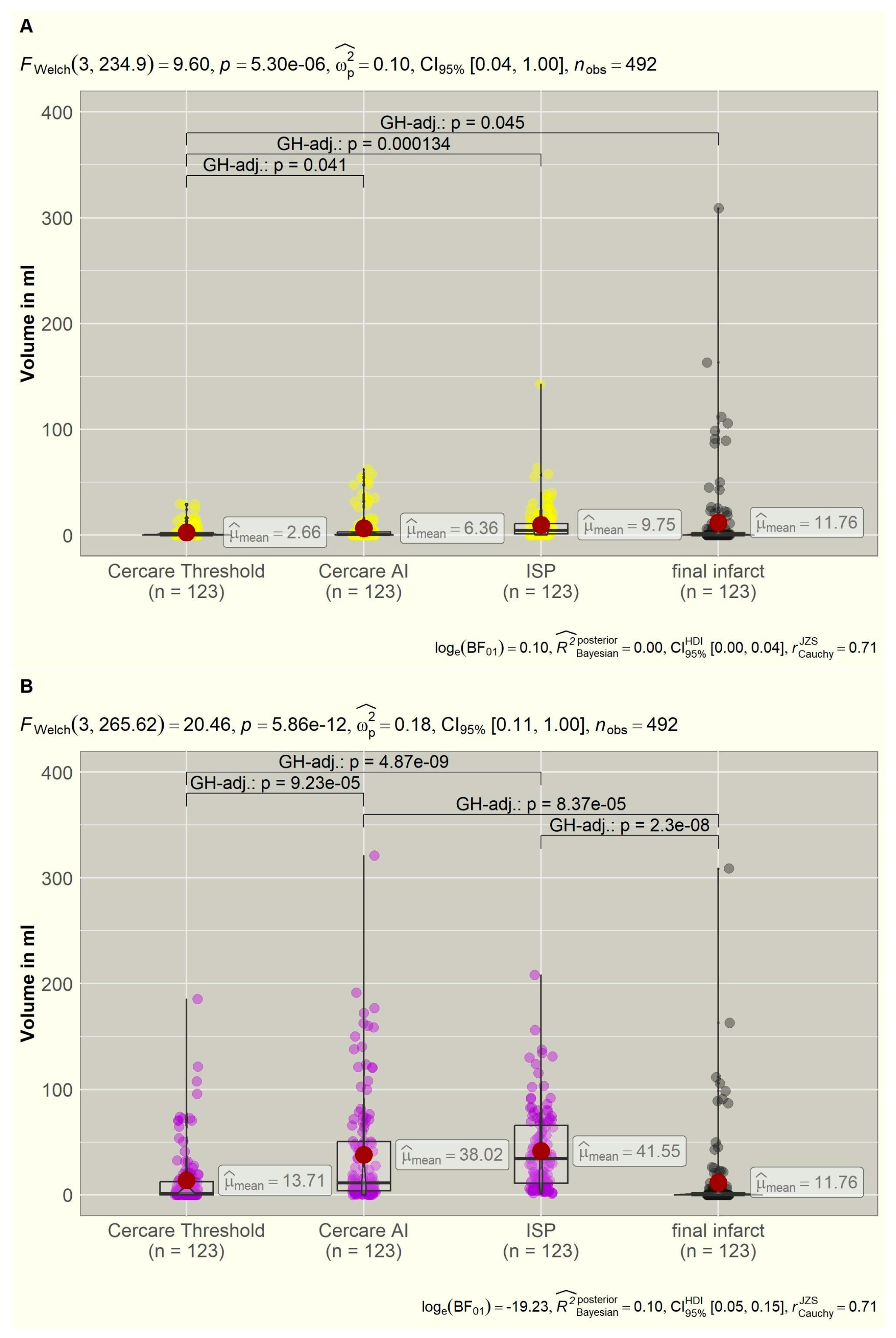
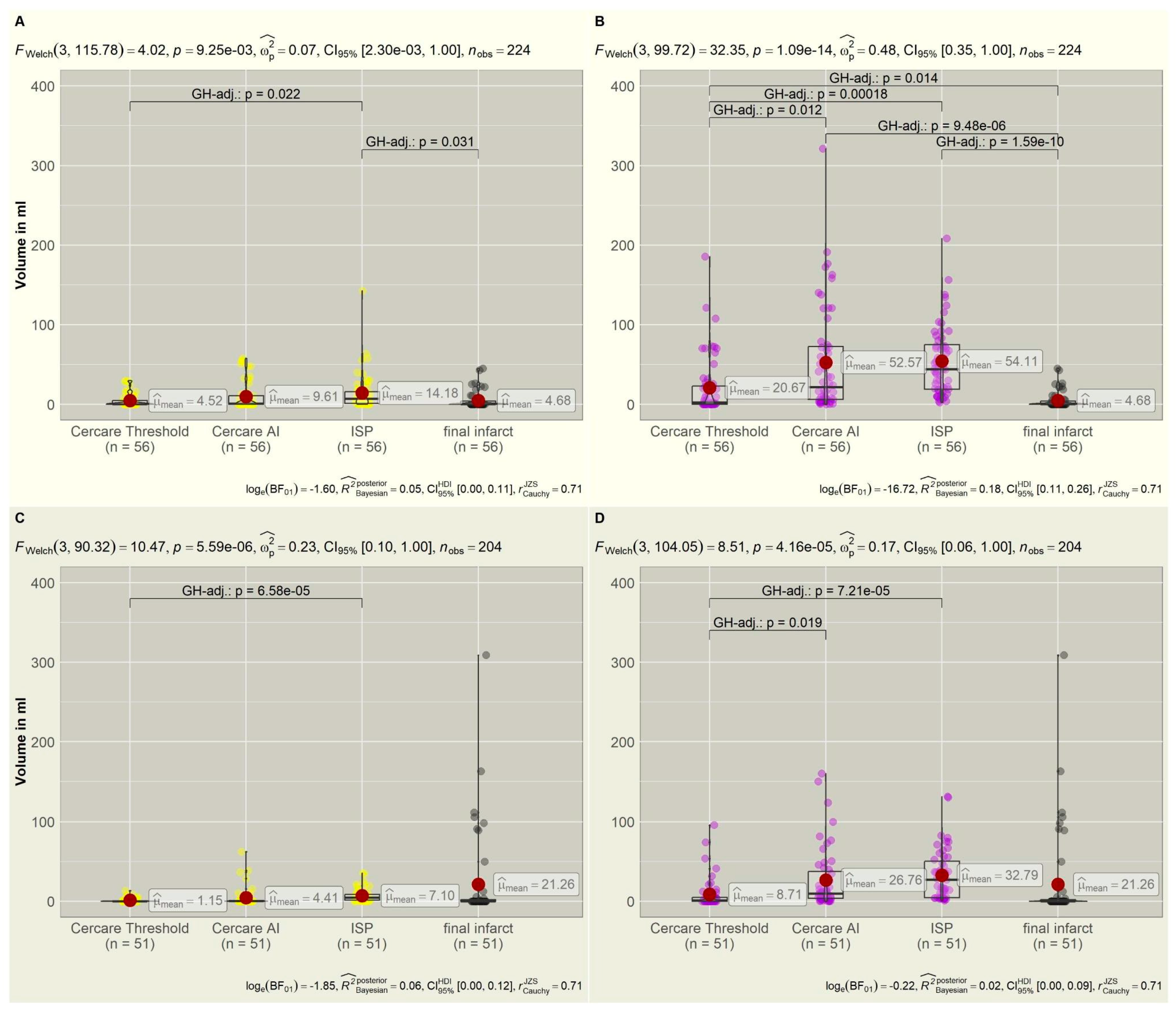
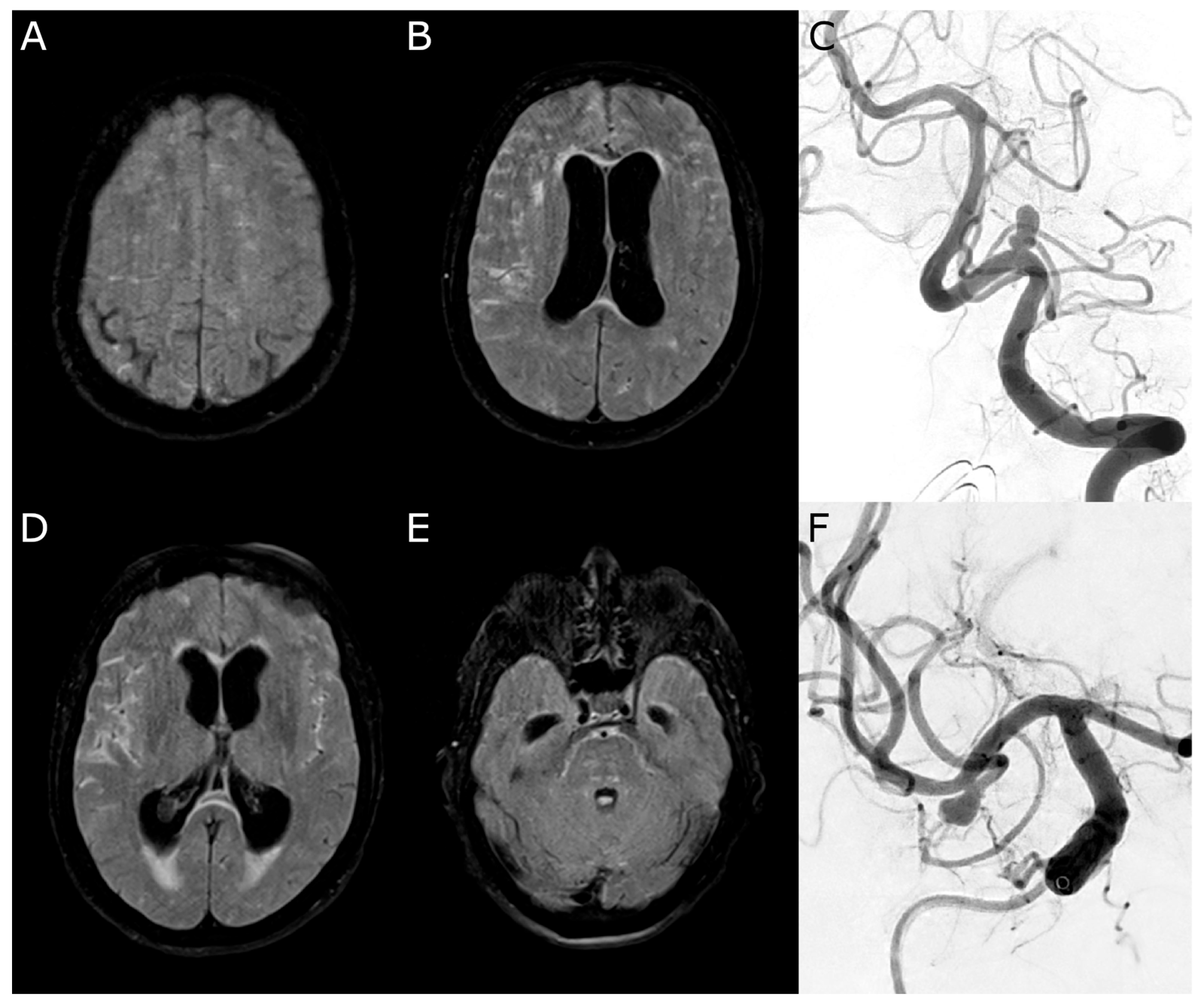
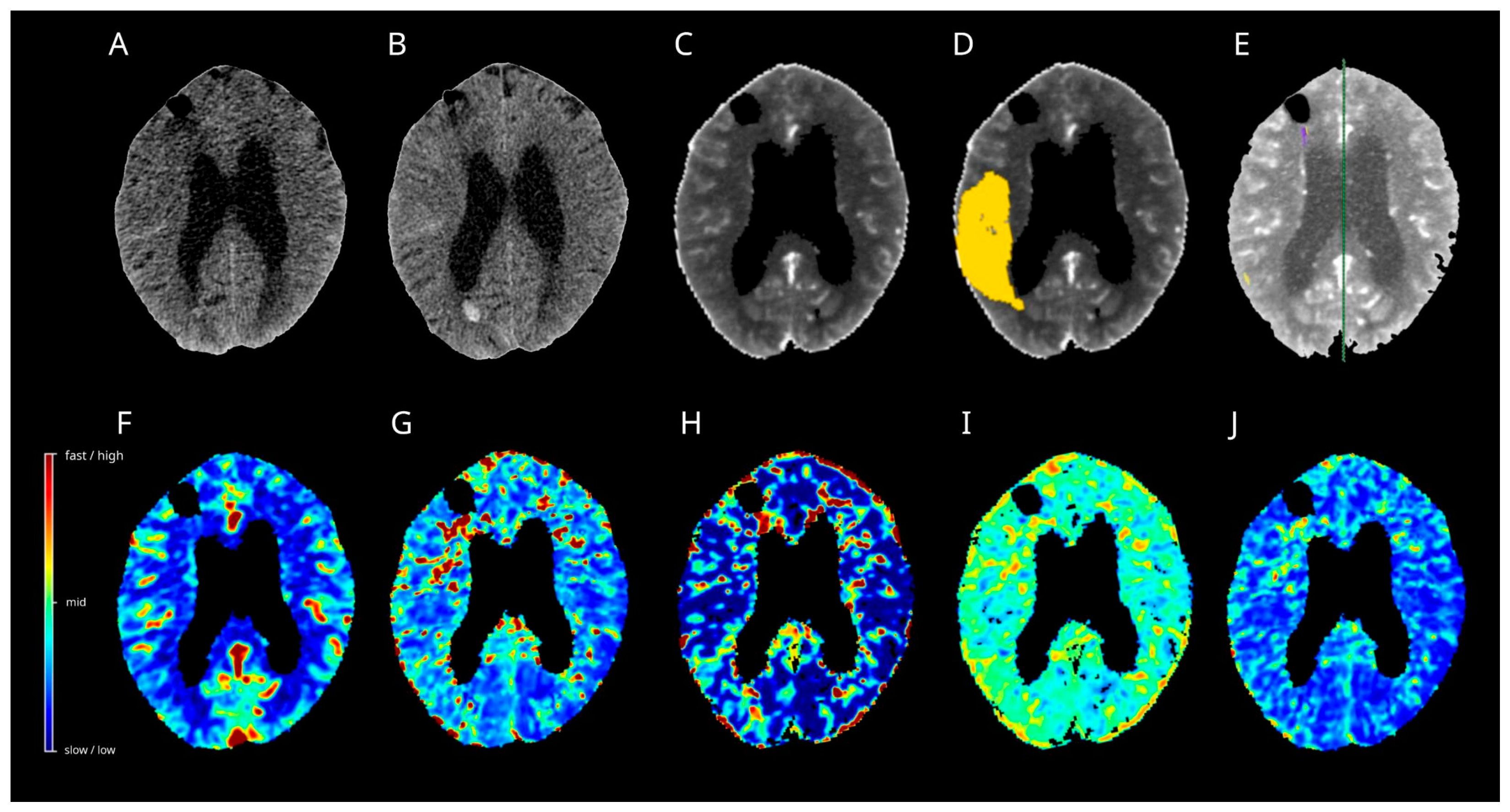
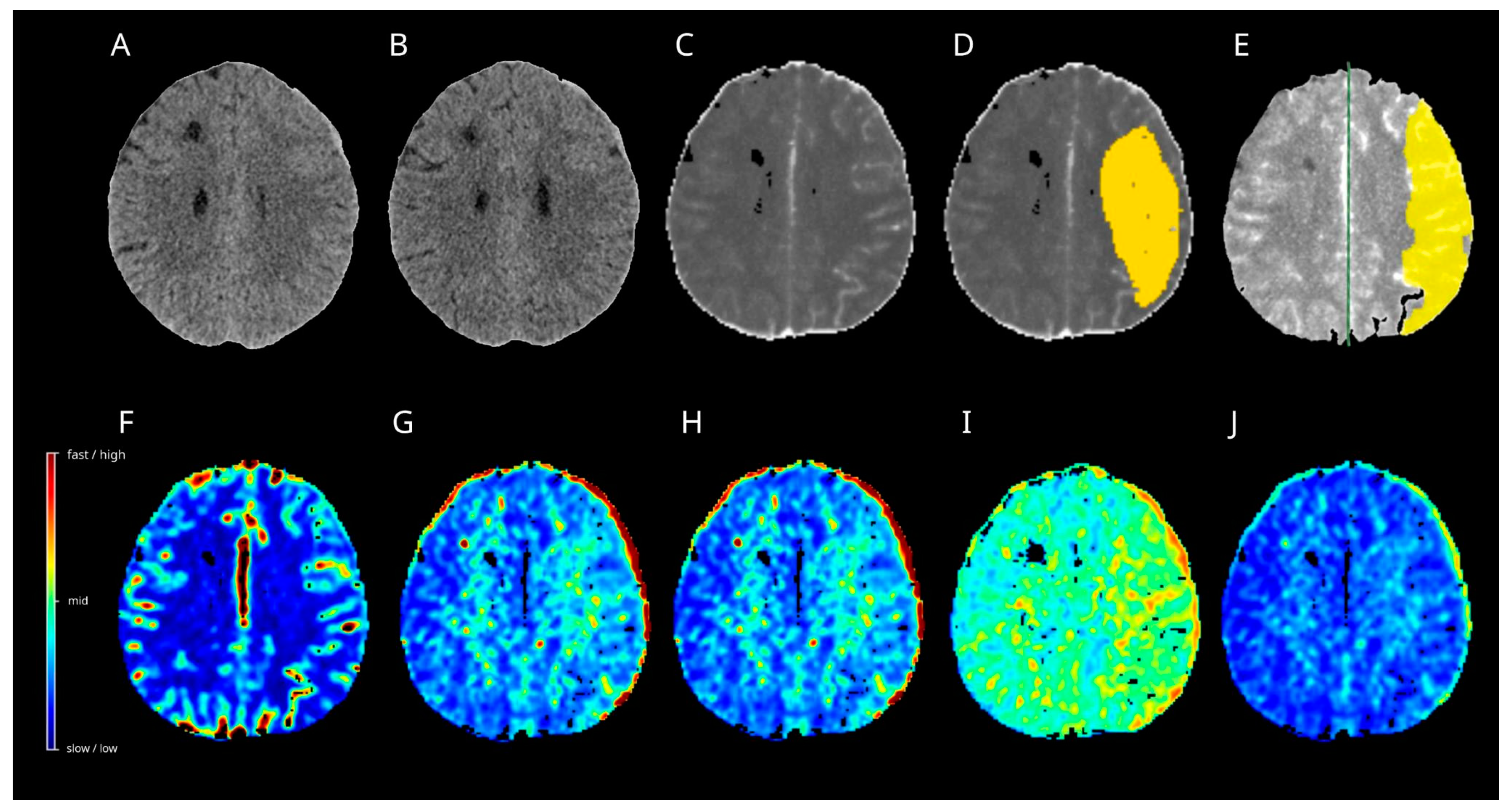
| Clinical characteristics on admission | ||
| Patients | 75 (100.0) | |
| Female (%) | 55 (73.3) | |
| Mean Age (range) | 56 (32–90) | |
| Mean BMI (range) | 27 (18–40) | |
| Fisher score (%) | 1–3 | 29 (38.7) |
| 4 | 46 (61.3) | |
| WFNS grading (%) | 1–3 | 44 (58.7) |
| 4–5 | 31 (41.3) | |
| Location of intracranial aneurysm | ||
| AComA (%) | 23 (30.6) | |
| PComA (%) | 8 (10.7) | |
| MCA Bifurcation (%) | 20 (26.7) | |
| Pericallosal artery (%) | 5 (6.7) | |
| ICA (%) | 8 (10.7) | |
| BA (%) | 5 (6.7) | |
| PICA (%) | 1 (1.3) | |
| VA (%) | 1 (1.3) | |
| Multiple (%) | 4 (5.3) | |
| Aneurysm treatment | ||
| Timing of aneurysm treatment in days (median, range) | 0.00 (0–19) | |
| Coiling (%) | 43 (57.3) | |
| Clipping (%) | 19 (25.3) | |
| Coiling + Clipping (%) | 4 (5.3) | |
| Flow diverter (%) | 4 (5.3) | |
| Coiling + Flow diverter (%) | 2 (2.7) | |
| Coiling + Contour device | 1 (1.3) | |
| WEB (%) | 2 (2.7) | |
| Delayed cerebral ischemia (DCI) | ||
| Clinical deterioration | 53 (70.7) | |
| DCI-related infarction | 32 (42.7) | |
| DCI treatment | ||
| Induced hypertension (%) | 13 (17.3) | |
| Intra-arterial spasmolysis (%) | 29 (38.7) | |
| None (%) | 33 (44.0) | |
| Outcome | ||
| mRS after 6 months (%) | 0–3 | 39 (52.0) |
| 4–6 | 36 (48.0) | |
| Volume | Cercare Threshold | Cercare AI | ISP | ||
|---|---|---|---|---|---|
| Overall | n (%) | 123 (100.0) | 123 (100.0) | 123 (100.0) | |
| Hypoperfused | mean (range) | 13.7 mL (0.0–185.5 mL) | 38.0 mL (0.0–321.2 mL) | 41.6 mL (0.8–208.4 mL) | |
| Core | mean (range) | 2.7 mL (0.0–29.5 mL) | 6.4 mL (0.0–62.4 mL) | 9.8 mL (0.0–142.9 mL) | |
| No abnormality | n (%) | 33 (26.8) | 4 (3.3) | 0 (0.0) | |
| Hypoperfused | mean (range) | 0 (0.0) | |||
| n (%) | 54 (43.9) | 46 (37.4) | 4 (3.3) | ||
| Core | mean (range) | 0 (0.0) | |||
| Underestimated progressive infarct | n (%) | 9 (7.3) | 0 (0.0) | 0 (0.0) | |
| Hypoperfused | mean (range) | 0 (0.0) | |||
| n (%) | 15 (12.2) | 7 (5.7) | 4 (3.3) | ||
| Core | mean (range) | 0 (0.0) | |||
| Reversible perfusion deficit | n (%) | 49 (39.8) | 78 (63.4) | 82 (66.7) | |
| Hypoperfused | mean (range) | 16.4 mL (0.1–185.5 mL) | 30.0 mL (0.1–321.2 mL) | 34.2 mL (0.8–156.2 mL) | |
| n (%) | 28 (22.8) | 36 (29.3) | 78 (63.4) | ||
| Core | mean in mL(range) | 6.4 mL (0.1–29.3 mL) | 12.0 mL (0.1–57.9 mL) | 8.1 mL (0.1–40.0 mL) | |
| Progressive infarct | n (%) | 32 (26.0) | 41 (33.3) | 41 (33.3) | |
| Hypoperfused | mean (range) | 27.6 mL (0.3–121.5 mL) | 57.0 mL (0.2–191.4 mL) | 56.3 mL (2.1–208.4 mL) | |
| n (%) | 26 (21.1) | 34 (27.6) | 37 (30.1) | ||
| Core | mean (range) | 5.6 mL (0.1–29.5 mL) | 10.3 mL (0.1–62.4 mL) | 15.3 mL 0.3–142.9 mL | |
| Sensitivity | Hypoperfused | 78.0% | 100.0% | 100.0% | |
| Specificity | 40.2% | 4.9% | 0.0% | ||
| PPV | 39.5% | 34.5% | 33.3% | ||
| NPV | 78.6% | 100.0% | / | ||
| Sensitivity | Core | 63.4% | 82.9% | 90.2% | |
| Specificity | 65.9% | 56.1% | 4.9% | ||
| PPV | 48.1% | 48.6% | 32.2% | ||
| NPV | 78.3% | 86.8% | 50.0% | ||
Disclaimer/Publisher’s Note: The statements, opinions and data contained in all publications are solely those of the individual author(s) and contributor(s) and not of MDPI and/or the editor(s). MDPI and/or the editor(s) disclaim responsibility for any injury to people or property resulting from any ideas, methods, instructions or products referred to in the content. |
© 2025 by the authors. Licensee MDPI, Basel, Switzerland. This article is an open access article distributed under the terms and conditions of the Creative Commons Attribution (CC BY) license (https://creativecommons.org/licenses/by/4.0/).
Share and Cite
Falter, L.K.; Halama, D.; Scherlach, C.; Arlt, F.; Starke, K.; Hoffmann, K.-T.; Richter, C. A Comparison of Three Perfusion Algorithms in Patients at Risk of Delayed Cerebral Ischemia After Subarachnoid Hemorrhage. Diagnostics 2025, 15, 2236. https://doi.org/10.3390/diagnostics15172236
Falter LK, Halama D, Scherlach C, Arlt F, Starke K, Hoffmann K-T, Richter C. A Comparison of Three Perfusion Algorithms in Patients at Risk of Delayed Cerebral Ischemia After Subarachnoid Hemorrhage. Diagnostics. 2025; 15(17):2236. https://doi.org/10.3390/diagnostics15172236
Chicago/Turabian StyleFalter, Lea Katharina, Dirk Halama, Cordula Scherlach, Felix Arlt, Kristin Starke, Karl-Titus Hoffmann, and Cindy Richter. 2025. "A Comparison of Three Perfusion Algorithms in Patients at Risk of Delayed Cerebral Ischemia After Subarachnoid Hemorrhage" Diagnostics 15, no. 17: 2236. https://doi.org/10.3390/diagnostics15172236
APA StyleFalter, L. K., Halama, D., Scherlach, C., Arlt, F., Starke, K., Hoffmann, K.-T., & Richter, C. (2025). A Comparison of Three Perfusion Algorithms in Patients at Risk of Delayed Cerebral Ischemia After Subarachnoid Hemorrhage. Diagnostics, 15(17), 2236. https://doi.org/10.3390/diagnostics15172236





